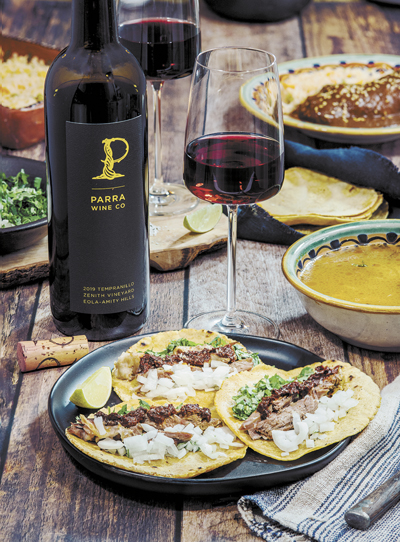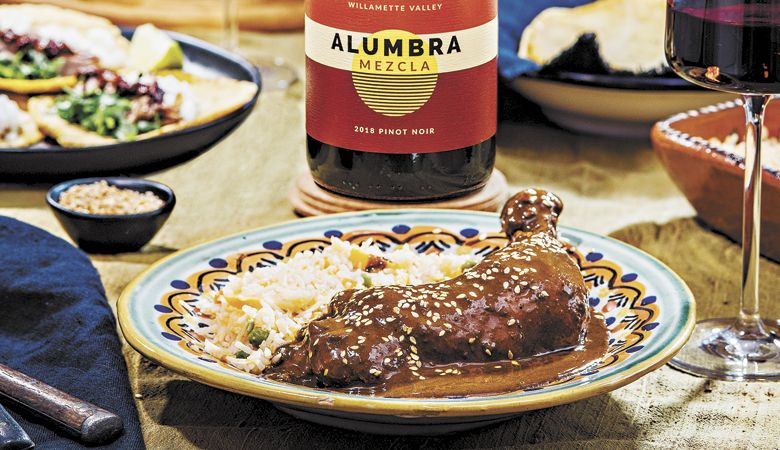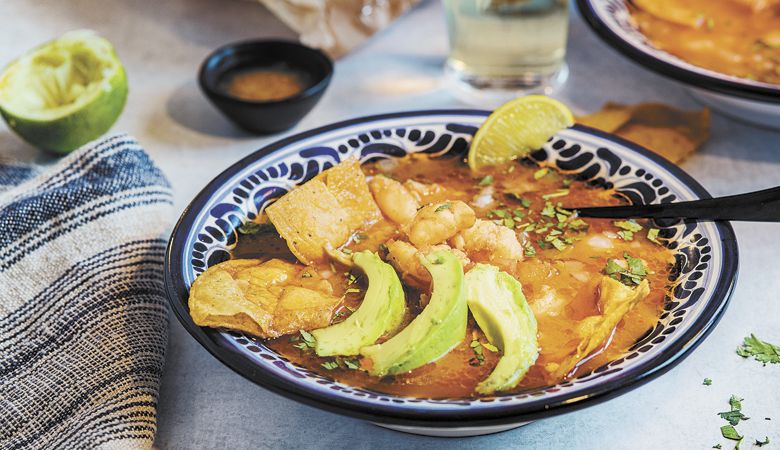Spice, Fruit, Acid, Earth
Matching Mexican fare with Oregon wines
Story by Annelise Kelly
Photos by Kathryn Elsesser
Americans devour Mexican food so frequently, we can hardly call it “foreign.” The cuisine flourishes from coast to coast, tempting us with many approaches, from traditional to inventive, from taco trucks to fine dining; in Portland, Nuestra Cocina and Xico both stand as shining examples of the latter.
However, there’s a culinary conundrum: Why don’t people drink wine with Mexican food?
We asked an expert.
Mexico City native Miguel Marquez works as a sommelier at Vino Veritas, a Portland wine bar and bottle shop. He explains Mexico’s deep wine roots. “In Coahuila, in the Parras Valley, we have the oldest vineyard in the Americas, since around 1596. It’s part of our history, part of our culture, part of our identity.”
Winemaking in Mexico is enjoying a renaissance. The flourishing wine region in the Valle de Guadalupe in Baja, California — “one of many winemaking valleys in Baja, each with its own climate,” says Marquez — has helped put Mexican wine on the map, and 14 of the 32 states produce wine at a commercial level.

So, why isn’t wine more popular with Mexican fare?
Can we blame the irresistible margarita? The robust Mexican beer industry and its high-caliber lagers and pilsners? The exotic allure of aguas frescas — horchata, tamarindo, Jamaica and more? Is it the cult attraction of classic Mexican Coca-Cola, cane-sweetened and bottled in glass? Is it a hot-climate stereotype, presuming a Mexican meal is invariably consumed on a palm-fringed beach?
It’s certainly not the food, which is diverse, flavorful and fragrant, capable of great subtlety, simmering with regional variety, and deeply expressive of geographic influences, from mountains to desert, from the Pacific to the Caribbean.
The food of Yucatán shimmers with tropical influence and Mayan roots, emphasizing banana leaves, citrus and corn. Veracruz, hugging the Gulf of Mexico, glorifies seafood and rice with a Caribbean flair. In Oaxaca, grasslands nourish a thriving cheese culture. In the arid north, sprawling ranches have elevated the grilling of beef and goats to an art form, with flour tortillas supplanting corn.
Mexico also is home to a long history of immigrants whose influence persists.
Lebanese migrants inspired tacos al pastor, pork grilled on a vertical spit. Other Mediterranean influences include olives, fragrant spices and rice. Afro-Caribbean culture supplied coconuts, sugar cane and peanuts. The French influenced the baking of bread and pastries, and Germans brought brewing of beer — along with the oompah-pah accordion of norteño music.
Sommelier Miguel Marquez
Marquez’ culinary credentials run deep. He was born into a restaurant family — they’ve operated Mi Cachito in Mexico City since 1961. He recalls, “My grandparents were my first teachers in the kitchen. They took care of me as a kid, and I would get curious about what they were cooking and how; that’s when I discovered storytelling through my grandparent’s recipes — storytelling that is now the backbone of my style as a sommelier.”
After a university education in hospitality, including culinary and wine coursework, Marquez sampled life north of the border, first at Walt Disney World and then at luxury hotel The Little Nell in Aspen, Colorado. Since February 2020, he’s served as sommelier at Vino Veritas, in Portland’s Montavilla neighborhood.
He finds much to love in Oregon’s thriving wine scene. “I like the climate we have here. Wines are not as ripe as the wines in California, which, personally, is a style I enjoy a little bit more. I think it’s a very underrated region for wine — there’s a reason we’ve been getting better known in the past decade.”
Alcohol Inflames Spice
When pairing wine with Mexican food, Marquez acknowledges, “The main factor is spicy food. You don’t want a lot of spice, especially with red wines, because the alcohol and the spicy sensation don’t match. Spice is exacerbated by alcohol, so that’s a little bit tricky.” He suggests going easy on the chiles. “We love the adrenaline rush from spicy sensations; it’s kind of addictive,” but toning down the heat is critical to achieving balance with alcohol, and “at the end, finding balance between wine and food is the goal of food pairings.” Generally, higher sugar and lower alcohol match best with spicy foods.
Fruit Tempers Spice
“A little sweetness goes a long way balancing the irritation of capsaicin. Also, ripe and overripe fruit conditions in wine can be experienced as sweet by our brains,” says Marquez. An Oregon Pinot Noir “which usually has lower tannins and lighter body with fruity tones, usually on the fresh side, can help counter that spiciness. Both Pinot Noir and Chardonnay from Oregon generally show less oak, so they are fruit-forward. The cool climate means lower alcohol. That fresh, fruity quality goes great with the complexity and spiciness of Mexican food.”
Match Acid with Acid
“Mexican seafood is great with white wine, say a Sauvignon Blanc, nice and fresh with tropical tones of pineapple and mango, and green notes of fresh-cut grass, high acidity. If you are going to have a ceviche with mango or pineapple, try a Sauvignon Blanc from the Van Duzer Corridor, or from the Eola-Amity Hills, which is cool climate, high acid. It just goes great because it’s light with light.”
When food tastes less spicy, Marquez endorses matching common qualities. For example, salpicón (shredded beef salad), “skirt steak with veggies, lettuce, onion, olive oil, oregano, a little bit of acidity with a touch of lemon or white wine vinegar at the end, goes great with a Grüner — nice and herb-y, yet showing body; it has that high acid again, nice and light.”
Acid Tempers Richness; Pair Earthy Flavors
“A Pinot Noir from here with a little oak, it has enough body. It’s dense enough to pair with mole or birria (goat) or tacos de suadero (tri-tip deep-fried in lard). They are all earthy. The food has very simple flavors; it’s fatty, so the acidity that our Pinot Noir achieves, thanks to the cooler diurnals shifts in Oregon, helps to cut through the richness of the tacos or the mole.”
Pozole blanco (white corn soup) “goes very well with the golden tones of a Chenin Blanc, also with a Chardonnay with a little bit of oak, not too much, just to give it a little bit of body. If we jump to a pozole rojo (red), try a rosé or a Riesling that can go perfectly with the slight spiciness that the red chiles add to the pozole rojo. It’s just fresh. Riesling generally tends to floral, aromatic and unctuous in the palate so it matches the weight of the dish.”
Experiment!
Why is it intimidating? Marquez suggests, “It’s outside of the comfort zone. I encourage people to experiment. If you’re going to have a taco night, get out some of your favorite wine. Just go for it and try it.” Consider the components of your meal: spice, acidity, fat, sugar, salt, bitter; experiment with wines that complement or temper those qualities.
“Every wine is a trip; every pairing is an adventure,” says Marquez. “It is OK not to succeed on all of them; it’s about the journey.”
Sopa de Lima with Shrimp and Habañero
Recipe from Chef Kelly Myers, Xico, Portland
Wine Pairing
Goodfellow Family Cellars Riesling
Yields 4 to 6 servings
Fish Stock (makes 7 cups)
1¾ pound medium shrimp (41/50 count), shells on
1 tablespoon vegetable oil
½ white onion, roughly chopped
½ stalk celery, roughly chopped
1 carrot, roughly chopped
½ teaspoon achiote seed
2 cloves garlic, crushed
2½ pound whitefish bones and heads, rinsed
¼ cup white wine
2 whole fresh or canned tomatoes
½ bunch fresh cilantro leaves
2 quarts cold water
Sopa
1 tablespoon extra-virgin olive oil
½ white onion, finely chopped
1 green bell pepper, diced
2 cloves garlic, finely chopped
2 Roma tomatoes, peeled, seeded and chopped
1 teaspoon salt
1/8 teaspoon ground black pepper
1/8 teaspoon Mexican oregano
1/8 teaspoon ground cloves
1/8 teaspoon ground allspice
2 bay leaves
* zest of ½ lime
6–7 cups fish stock
Chile con Lima
3 habañero peppers
½ cup freshly squeezed lime juice
* pinch of sea salt
Assembly
* fresh cilantro leaves, for garnish
1 avocado, diced
30 totopos or tortilla chips
Step 1: Fish Stock
Remove shells from shrimp and set aside. Refrigerate shrimp until ready to use. Heat oil in stockpot set over medium-low heat. Sauté onions, celery, carrots and achiote seed for 10 to 15 minutes until softened. Add garlic and sauté for 3 minutes.
Add shrimp shells and whitefish bones and heads, stir, and cook until shells begin to turn pink. Add wine, tomatoes, cilantro and cold water. Bring to a simmer over high heat, reduce to medium-low and cook, uncovered, for 30 to 40 minutes.
Strain stock through a colander set over a large bowl, and discard solids. Allow to cool, and skim off any fat that rises to surface. You should have 6 or 7 cups. Top off with water if necessary. (Stock can be made several days ahead. Allow to cool, and then refrigerate. Scrape off any fat that solidifies on surface before using or freezing for longer storage.)
Step 2: Sopa
Heat oil in saucepan over medium heat. Add onions and bell peppers and sauté, stirring occasionally, for 5 minutes, until onions are translucent. Add garlic and sauté for another minute, until fragrant. Add tomatoes, salt, pepper, oregano, cloves, allspice, and bay leaves and cook for about 8 minutes, until tomatoes are softened. Add lime zest and cook for another minute.
Stir in stock and bring to a simmer over medium-high heat. Reduce to medium-low and simmer for 10 minutes. Cut shrimp crosswise into thirds. Stir in shrimp and cook for 3 minutes, or until shrimp are cooked through.
Step 3: Chile con Lima
Wearing protective gloves, slice habañero peppers crosswise into very thin rings. Combine peppers, lime juice and salt in small non-reactive bowl. Marinate for 30 minutes. (The condiment is intended to be very spicy. One way to enjoy it with less heat is to spoon some of the lime juice into your soup, avoiding chiles.)
Step 4: Assembly
Divide sopa among bowls. Garnish with cilantro, diced avocado and fried totopos or tortilla chips. Serve with chile con lima on side, for drizzling.
Molé Poblano
Recipe from Miguel Marquez, based on his abuela’s recipe served in Mexico City since 1961
Wine Pairing
Alumbra Cellars 2018 Mezcla Pinot Noir
Yields 10 cups (20 to 25 servings)
Chiles
3 ounces dried ancho pasilla (about 6), de-stemmed and seeded
3 ounces dried guajillo (about 6), de-stemmed and seeded (reserve seeds)
3 ounces dried mulatos (about 6), de-stemmed and seeded
½–1 ounce dried chipotle
Seeds and Spices
* reserved seeds from guajillo chile (½ cup maximum)
4 tablespoons sesame seeds
3 whole cloves, stems removed
¼ teaspoon anise seeds
¼ teaspoon coriander seeds
½ teaspoon whole black peppercorns
1 stick of cinnamon (not ground)
¼ teaspoon ground allspice
Bread and Vegetables
2 corn tortillas sliced into eighths
½ bolillo roll or baguette (about 2 ounces) thickly sliced (ideally a few days old)
½ pound Roma tomatoes, diced
1–2 plantains, sliced
Nuts and Fruits
¼ cup vegetable oil
½ white onion, roughly chopped
4 large garlic cloves, peeled and roughly chopped
3 tablespoons raw almonds with skin
3 tablespoons raw shelled peanuts
3 tablespoons raisins
3 dried plums
Other Ingredients
6 ounces dark Mexican-style chocolate, chopped (such as Ibarra or Nestle Abuelita)*
1 quart or less warm chicken broth, as needed
1 cup or less lard, as needed
2 teaspoons kosher salt, to taste
½ cup sesame seeds, toasted (sprinkle on final dish)
Step 1: Chiles
In large hot, dry pan, toast the chiles. Add chiles in 2 or 3 batches; toast about 5 seconds on each side, or until they blister. Remove and place in warm water to soak. Don’t burn them or they will become bitter and overly spicy. Set aside.
Step 2: Seeds and Spices
Dry toast the spices. Stir frequently and let cook for 3 to 4 minutes until toasted and fragrant, stirring often. Set aside to cool.
Step 3: Bread and Vegetables
Dry toast tortillas and bread; remove from skillet. Add some chicken broth to soften, set aside. Fry tomatoes and plantains until the tomatoes are charred. Set aside.
Step 4: Nuts and Fruits
Heat ¼ cup of vegetable oil in skillet. Add chopped onion and garlic and sauté for 2 to 3 minutes, stirring, until they soften and release their aroma. Stir in the nuts and dried fruit, and let cook for 2 to 3 minutes. Set aside.
Step 5: Creating the Sauce
Grind dry, cooled spices in spice grinder or high-powered blender. Set aside. Use blender for remaining components (bread, vegetables, nuts, fruits) to achieve the smooth texture molé requires, adding chicken broth as needed to loosen ingredients into a paste. Set aside. Drain chiles; discard water. Process chiles with some chicken broth; fry paste with some lard in large, deep pot. Stir bread-veggie-nut-fruit paste into frying chile paste. Add ground spices.
Once it comes to a simmer, add chocolate and salt. Mix well and let simmer on low heat for 12 to 15 minutes. Stir frequently to prevent burning. Turn off heat, still stirring frequently to prevent burning as it cools. Cover and let the sauce rest for at least half an hour to allow chiles to soften completely.
At this point, you have molé paste. To create molé sauce, add additional chicken broth to achieve the thick sauce consistency of Molé Poblano. Start with two parts molé paste to one part stock, and adjust as needed. Serve over cooked chicken or turkey and sprinkle with toasted sesame seeds, with red tomato rice on the side.
*Note from Miguel: If you can’t get Mexican-style chocolate, then molasses or sugar, but as a Mexican, I wouldn’t consider that traditional molé. Also, getting products from a recipe’s place of origin ensures that some money goes to that culture, and defuses a little of the cultural appropriation from colonialism, as well as preserving their traditions.











